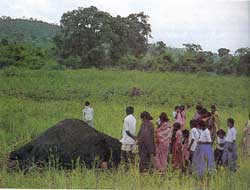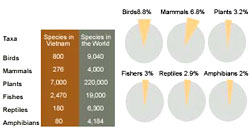
Science through fun and games
To put together an exhibition on the environment for children was an excellent idea. Now, the ministry of environment and forests should consider taking it to rural areas.

To put together an exhibition on the environment for children was an excellent idea. Now, the ministry of environment and forests should consider taking it to rural areas.

The fisheries department sets new rules for acquafarmers to avoid the recurrence of a viral devastation

A MEF proposal wants to do away with environmental clearance for small scale mining

Wherever there is construction, there is corruption. The foundation of most projects rests on commissions, bribes and kickbacks

Biodiversity conservation has revolved around creation of lists that prioritise species for protection. Conservation laws of many nations create lists of species to be protected, while international instruments, such as the <font class="UCASE">cites</font>, have appendices listing species that are prioritised for protection. The best-known of these is the World Conservation Union-International Union for the Conservation of Nature's (<font class="UCASE">iucn</font>) Red List. <br>

India hardsells its troubled protected areas abroad
<p><span style="font-size:14px;"><strong>Fisheries - Shrimp Cultivation</strong></span></p> <p><img alt="Fisheries" src="http://www.indiaenvironmentportal.org.in/files/country/bangladesh/fisheries_hl.jpg" style="width: 530px; height: 300px;" /></p> <p>Shrimp cultivation began in Bangladesh in the mid-1970s when exports totaled 4.7 million dollars a year.</p> <p>Until the global economic crisis, it was a 534-million-dollar-a-year business, with 42,000 tons of exports, mainly to the United States and Europe. After the garment industry, shrimp production ranks second in Bangladesh in terms of the sector’s ability to earn foreign exchange. Not only does this crop earn valuable foreign exchange, but the sector also employs significant numbers of rural workers and provides a livelihood for households throughout much of Bangladesh. A study by USAID estimates that as many as 1.2 million people may be directly involved in shrimp production with an additional 4.8 million household members supported by the industry.</p>
<table bgcolor="#f2f2f2"> <tbody> <tr> <td> <p><img border="0" src="http://www.indiaenvironmentportal.org.in/files/html/eds_insidebanner.jpg" /></p> <div style="width:100%; height:660px;

Rudyard Kipling gave us unbelievable stories about the humane wolf. Now, a court decision reaffirms the animal's vital role in the ecosystem

Sagar Refugee Colony, Ganga Sagar <i>gram panchayat</i>: Ever since her older son went off to work as a daily labourer in Kashmir two years ago, Sahajadi Bibi has to worry a little less about how to feed her family of eight.

This is a true story of the beautiful state of Kerala, of its famed backwaters and wetlands, of its rain swept Western Ghats. It also speaks of the grime beneath the hype of a state which is home to "a generation on crutches", and of the environmental h

The birth pangs of development have been faced so far by the downtrodden, but things need to change soon

A study explains why peaceful pachyderms go on rampages that leave crops and humans devastated

About 11 million people in Orissa and Bihar have become victims of a famine that has occurred despite adequate food stocks in the country.

What happens if conservation is based on half baked knowledge? Ask a person rendered homeless by wildlife managers <br><br> No conservation strategy will succeed in India unless the biomass requirements of the local communities are harmoniously integra

Jharkhand"s leaders have successfully pressurised the Centre to consider granting autonomy to this region. But they have still not addressed themselves to local ecological problems

Pollinators, small insects like bees and butterflies, animals like bats and small birds such as the hummingbird, play a big role in helping plants propagate. Their populations are declining rapidly. If they die out, so will the plants that depend on them

In Vietnam, an astonishing array of species, some never before encountered by humans, are being threatened by deforestation and an illegal trade in wildlife. However, the government is waking up to the need for preserving this heritage. But are the refor

“There is radiation everywhere on earth. Mining in Nalgonda will not increase it.” This comment of S D Prasad, adviser to public sector undertaking Uranium Corporation of India Limited, typifies the Indian authorities’ disregard for the impact of uranium
In any democratic country, environmental concerns can get integrated with developmental programmes only if the leader is sensitive to them